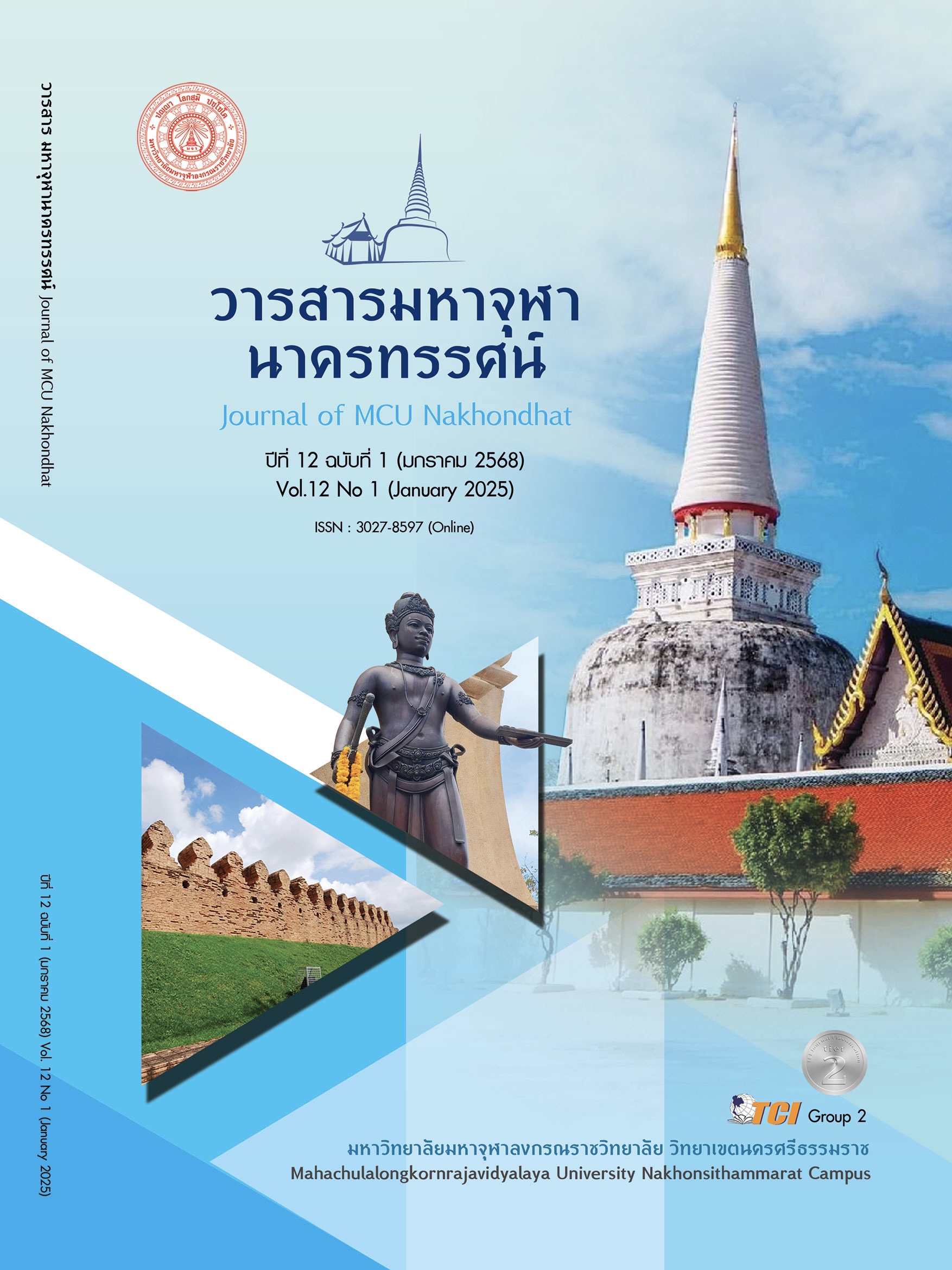AN ANALYTICAL STUDY OF THE DHUTANGA PRACTICE PRINCIPLE OF MONKS IN SAKON NAKHON PROVINCE
Main Article Content
Abstract
The purpose of this study was to study the practices of Dhutanga Vatta in Theravada, the methods of practices of Dhutanga Vatta of monks and to analyze the practice of Dhutanga Vatta of monks in Sakon Nakhon Province. That is a Qlanlitative Research, in-depth interviews, and observation. The research results found 1) The practices of Dhutanga Vatta in Theravada Buddhism are practices but not precepts: Pangsukulikanka (wearing cloth that is completely dry), Tejivarikanka (wearing the triple robe), Sapatancarika (going on alms round in sequence), Khupacchabhattika (prohibiting eating later), Arannika (living in the forest), Yathasanthatikanka (living in a place provided by others), Nesajjikanka (sitting), the effort of the three postures of sitting, standing and walking. 2) Methods of practices of Dhutanga Vatta for monks according to the factors that will facilitate, wearing the triple robe, going on alms round, staying to the arranged place of residence regardless of whether it is convenient or not, living in the forest, the practices of Dhutanga Vatta according to faith and following the discipline that teachers have practiced and passed down. Training in the practices of Dhutanga Vatta is a process, that is, training disciples, giving advice on developing the mind, teaching Vipassana meditation. And 3) The practices of Dhutanga Vatta of monks in Sakon Nakhon Province is to purify their defilements to become people with few desires, content, easy to support and live easily, to practice regularly, adhering to the methods according to the Buddha's teachings that teachers have given training, taught and passed on, as Luang Pu Man Phurithatto has practiced throughout his life as a revered ancestor, with disciples following him and being accepted and respected to this day, giving training, advice and consultation, which are somewhat different in each school, but they strictly adhere to the principles of Theravada Buddhism, the According to strict Buddhist discipline.
Article Details

This work is licensed under a Creative Commons Attribution-NonCommercial-NoDerivatives 4.0 International License.
References
พระครูปลัดทินกร อิสฺสโร และคณะ. (2565). ธุดงควัตร : แนวทางพัฒนาศาสนทายาทในพระพุทธศาสนา. วารสารปรัชญาปริทรรศน์, 23(1), 80-93.
พระครูสิริกิจจาภรณ์เสริม กตกิจฺโจ. (2549). โสสานิกธุดงค์ในพุทธศาสนาเถรวาท : กรณีศึกษาหลวงพ่อเกษม. ใน วิทยานิพนธ์พุทธศาสตรมหาบัณฑิต สาขาพระพุทธศาสนา. มหาวิทยาลัยมหาจุฬาลงกรณราชวิทยาลัย.
พระ ไพศาล พหุสุตฺโต (สุมาลี). (2558). วิธีการสร้างศาสนทายาทของพระสายปฏิบัติในจังหวัดสกลนครศิลปะศาสตร มหาบัณฑิต สาขาวิชาพุทธศาสนศึกษา ภาควิชาปรัชญาและศาสนาคณะมนุษยศาสตร์ มหาวิทยาลัยเชียงใหม่. วารสารปณิธาน, 11(16), 130-146.
พระมหาจรูญ ปญฺญาวโร. (2541). การศึกษาบทบาทของพระมหากัสสปเถระในการเผยแผ่พุทธศาสนาเถรวาท. ใน วิทยานิพนธ์พุทธศาสตรมหาบัณฑิต สาขาพระพุทธศาสนา. มหาวิทยาลัยมหาจุฬาลงกรณราชวิทยาลัย.
พระมหาสุชญา โรจนญาโณ. (2541). การศึกษาบทบาทของพระโมคคัลลานะเถระในการเผยแผ่พุทธศาสนาเถรวาท. ใน วิทยานิพนธ์พุทธศาสตรมหาบัณฑิต สาขาพระพุทธศาสนา. มหาวิทยาลัยมหาจุฬาลงกรณราชวิทยาลัย.
พระสุทัศน์ กตสาโร. (2556). การศึกษาธุดงควัตรในพระพุทธศาสนา: กรณีศึกษาแนวปฏิบัติธุดงควัตรของวัดพระธรรมกาย ปทุมธานี. ใน ดุษฎีนิพนธ์ปรัชญาดุษฎีบัณฑิต สาขาพระพุทธศาสนา. มหาวิทยาลัยมหาจุฬาลงกรณราชวิยาลัย.
พระอาจารย์มหาบัว ญาณสัมปันโน. (2551). ประวัติท่านพระอาจารย์มั่น ภูริทตฺโต. กรุงเทพมหานคร: บริษัทศิลป์สยามบรรจุภัณฑ์และการพิมพ์ จำกัด.
มหามกุฏราชวิทยาลัย. (2525). พระไตรปิฎกภาษาไทย. ฉบับมหามกุฏราชวิทยาลัย: พระสูตรและอรรถกถาแปล. กรุงเทพมหานคร: โรงพิมพ์มหามกุฏราชวิทยาลัย.
สมเด็จพระพุฒาจารย์(อาจ อาสภมหาเถร). (2547). คัมภีร์วิธิมรรค พระพุทธโฆสเถระ รจนา. (พิมพ์ครั้งที่ 5). กรุงเทพมหานคร: ประยูรวงศ์พริ้นติ้ง จำกัด.
สมเด็จพระพุทธโฆษาจารย์ (ป.อ.ปยุต.โต). (2561). การพัฒนาที่ยั่งยืน. (พิมพ์ครั้งที่ 21). นครปฐม: วัดญาณเวศกวัน.


